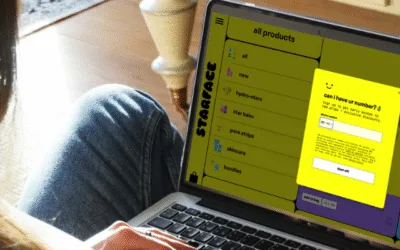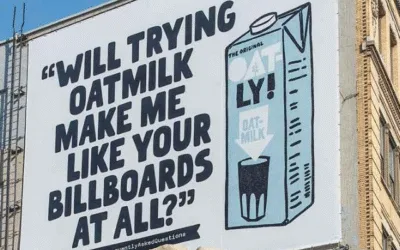Peachies beat Pampers by selling sleep, not nappies. Learn their Ladder of Why messaging trick to make your copy resonate.
Your customers have already written your best copy (you just have to steal it)
Sometime you don't have to write your own copy, your customers can do it for you. Find out how to mine your reviews for 🔥 copy.
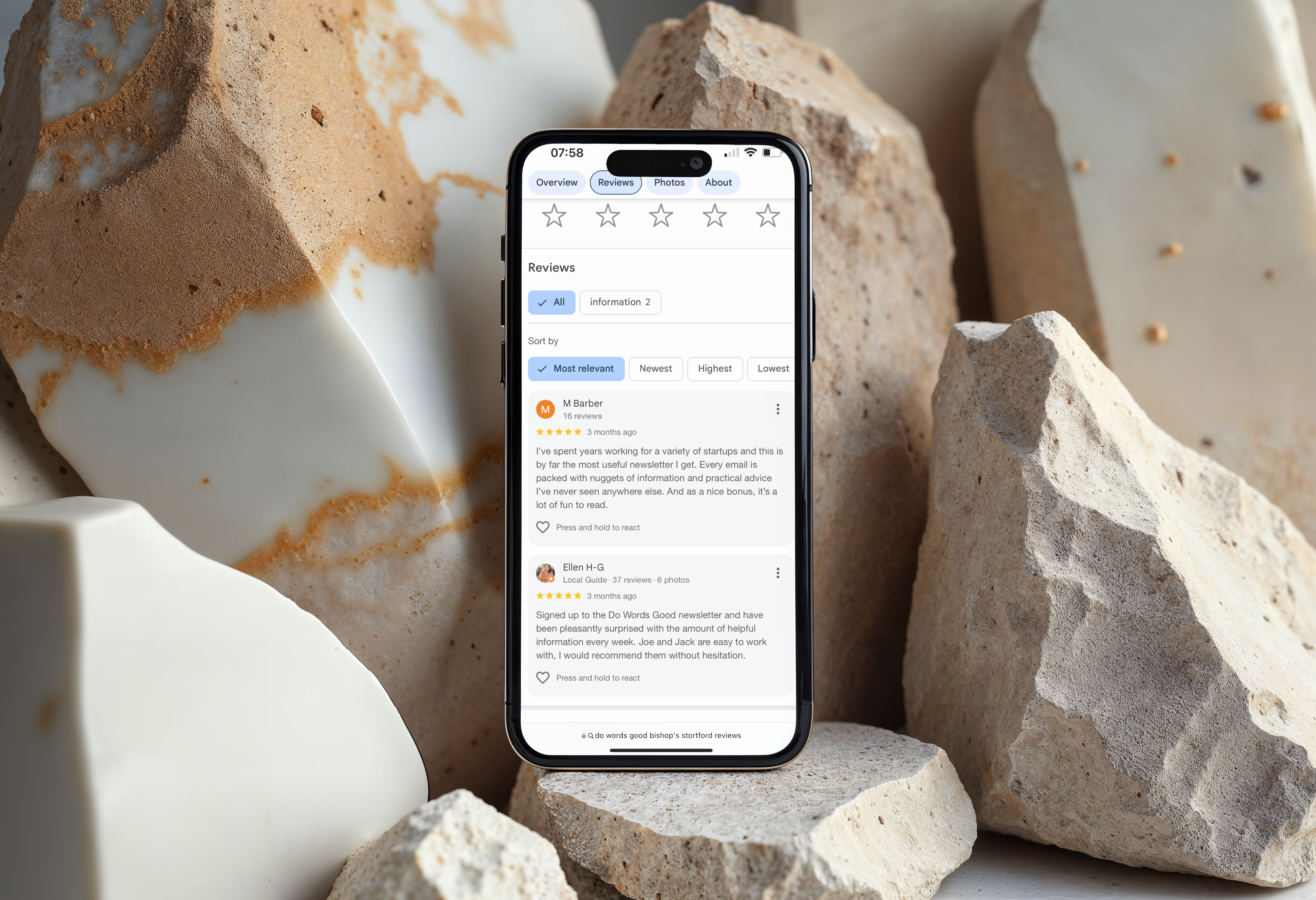
Get pro copy tips, branding tricks and e-comm insights directly to your inbox every Tuesday.
Before we get into this, we’ll keep it real: this week’s copy tip is about as unsexy as you can get.
(Think Boris Johnson starring in 50 Shades of Grey levels of sexy. We’re sorry for that mental image. Really.)
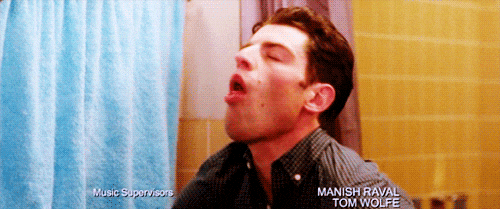
And while it’s unsexy as hell, this tip/mindset tweak is an absolute game-changer for writing copy that makes customers feel seen, understood, and ready to buy.
And our favourite part? You don’t have to write a single word.
No staring at a blank page. No pulling ideas out of thin air. No staving off an “I think I’d like to go live in a cabin in the woods and live off the land instead of write another word” existential crisis.
Nope. You just get to scroll Reddit, Instagram, and customer reviews, and call it work.
Let’s get into it 👇
💡 This week’s big idea: how mirroring your customers’ language can make them more likely to buy.
Did you know that when an FBI hostage negotiator arrives on scene, one of the first things they’re trained to do is to listen to how the hostage-taker talks and what words they use and then mirror them back to them.This builds an instant bond and trust and significantly improves the chance of a successful negotiation.
In sociolinguistics, this matchy-matchy language technique has a name: it’s called linguistic style matching, or LSM.And whether you’re trying to negotiate the release of a hostage or just get people to buy your new kombucha, mirroring the way they talk is super powerful.
Whenever we speak to a brand that’s stuck spinning its wheels on what to write or how to position their product, one of the first things we ask is: how do your customers talk about your products?
You see, while it’s only natural to feel like you need to start from scratch (or fire up ChatGPT), 9 times out of 10, the best bits of copy are already sitting there, waiting to be used.
All it takes is a bit of digging around in things like your…
👉 Customer reviews
👉 Social media comments on your posts
👉 Emails & DMs customers send you
👉 Reddit threads
👉 Competitor reviews
… and you end up with a whole document of copy ideas, phrases real customers use and a list of pain points that your products solve.
🧠 Why this works: The science and psychology of message mining
👉 A study of Amazon book reviews found that reviews written in a style that matches the target audience’s typical language led to higher conversion rates. In other words, stuff written in the way the audience speaks has a much greater influence on purchase behavior than the same message written another way.
👉 In a conversion optimization test, CXL found that just incorporating customers’ own words into a homepage headline and copy improved on-page conversions by 9.2%.
👉 Some of this comes down to idea of self-congruity, which basically suggests that we all prefer brands with personalities that match our own self-image. If your brand talks like your customers and represents their values, they are more likely to feel connected to you and to buy from you.
👉 On top of that, using our customers’ words improves the cognitive fluency of our writing. Basically, by speaking in a way that feels familiar, we make it easier for our customers to understand what we’re saying. And the easier something is to understand, the more we instinctively like it, trust it, and engage with it.
⚡ How can you put this to work for your brand?
This is the good bit. Grab a coffee (or tea, kombucha, beer, wine, whatever…) and read through your customer reviews and social media comments
However, rather than approaching it with a “which comment would be best to showcase on social media?” mindset, go full Sherlock Holmes. Try and read between the lines.
✅ What are customers raving about time and time again? What’s actually important to them?
✅ Are there any words, phrases or ideas that keep cropping up again and again?
✅ Are there any pain points they’re saying that your product solves over and over again?
(Quick note: pain point doesn’t have to be a life or death pain point. It could be as simple as “I used to hate eating healthy, but now I don’t mind it.”)
✅ Look for any funny, quirky or attention-grabbing phrases that you can reuse. If a customer gets really specific on details, grab those too. You can use them later to make your copy feel more concrete and real.
Here’s our tip: Look for patterns, not just one-off comments. If multiple people are saying the same thing, that’s where you should start digging for gold.
👉 Example: If loads of customers say your protein bars are the “only ones that don’t taste like chalk,” or “the only ones that don’t leave a funky taste in my mouth”… that’s your hook. Give it a little tidy and you’ve got a new headline that’s going to speak directly to your customers.
💡 Once you’ve struck gold, start a swipe file
At DWG, we have a Notion file full of screenshots of comments from social media, forums and replies to our emails about what copywriting problems brands struggle with. If we’re ever writing a new page for our site, that’s the first place we start.
In fact, one bit of copy on our site (copy that makes people say holy shit that’s the brand for me) came directly from a call with a client.
So next time you see a social media comment or review that feels like it says something useful, grab a screenshot and stick in a file. (Or, just leave them to sit in your camera roll for months until you remember to organise them, just like us pros do.)
Then when you need to write copy, revisit it and you’ll more than likely find that your customers have already done the hard work for you.
🔍 Don’t have many reviews yet? Steal from your competitors and Reddit
If you’re a newer brand without a decent amount of customer feedback yet or you’re launching a new product, never fear. You can still mine for copy gold, you just need to look elsewhere. (And get a bit creative with it.)
Here’s where we usually start digging 👇
✅ Competitor reviews. Take a look at 1-star and 5-star reviews of your competitors. The 5-star reviews show what customers actually value which is helpful, but the 1-star reviews show you opportunities to double-down.
For example, if all your competitors reviews are like “I feel great after drinking these greens, but I do have to hold my nose to drink them”, then you’ve found yourself a really great headline idea. “The green smoothie you’ll actually enjoy drinking” or “All of the benefits. None of the nose-holding.”
✅ Reddit & forums. Reddit is always the first place we go for Voice of Customer research. (Which is the fancy name for this process.)
Because they’re anonymous, Redditors give brutally honest opinions on their problems and other products they’ve tried. Head to Reddit and search for your product category and see what they’re saying. Even better, sort your results by Top and All Time to find the real gold.
👉 Example: If you see a Reddit thread where people complain that “every luxury candle smells amazing but burns out too fast,” your product page can play on that. “A luxury candle that’ll stay burning as you binge a whole season of SVU and call it self-care.”
(Notice that little SVU detail in the copy, that’s the kind of detail you can find as you’re digging around that makes your copy feel more real, concrete and memorable.)
Let’s see it in action 👀
There’s really no place that these little buyerisms don’t come in handy. We use them all the time in headlines, email subject lines, ad copy… because they’re just so damn effective.
Let’s work through an example brief, step-by-step to turn buyerisms into 🔥 copy.
💡The brief: write a new hero section for a meal replacement brand that wants to compete with Huel.
Step 1: As we’re launching a new brand, we’ll want to take a look through our competitors’ customer feedback looking for stuff that is:
✅ Memorable, attention-grabbing or just phrased in a way that sticks with us after we’ve scrolled.
✅ Saying something that lots of other customers are saying too.
So, we head to Reddit and Trustpilot to look into Huel.
And we find lots of comments about the taste and the aftertaste.
(Note: Jack is editing this email while drinking a Huel, so this doesn’t reflect our personal feelings on the brand.)
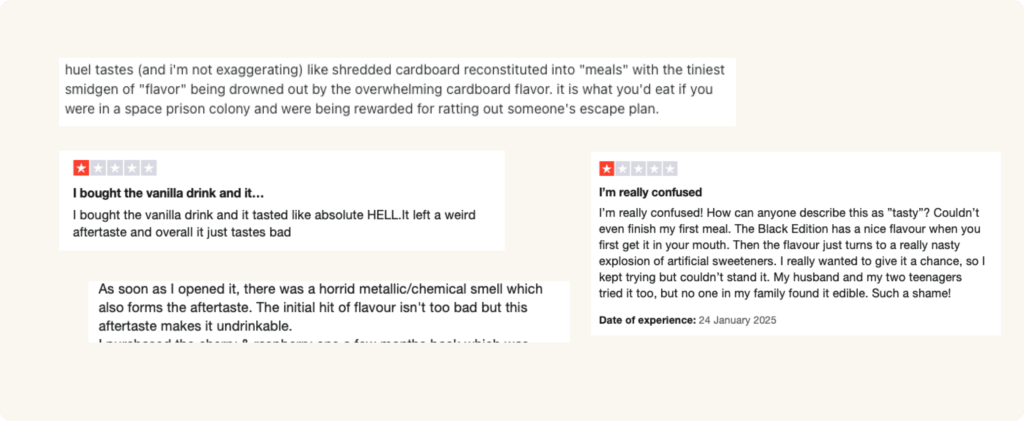
2) The next step is to play around with those ideas to come up with a v.1 headline or concept.
The main pain point seems to be around taste/aftertaste.
So our early v.1 could be something like “All of the on-the-go health benefits. None of the funky aftertaste.”
That’s pretty good. A solid B-.
But it feels a bit too safe. Like it’s missing just a little flourish to make it really memorable.
Time to head back to the VOC research…
3) Because it feels like copy is a bit flat and everyday, we’ll look for something to punch it up with. (Usually a bit of humour or a throwaway joke from a customer.)
Everywhere people commented on Huel, they mentioned the free tshirt. “Hated the drink, loved the t-shirt”, etc…
So we could lean into that (if we wanted to go for that challenger brand energy) and end up with something like this 👇
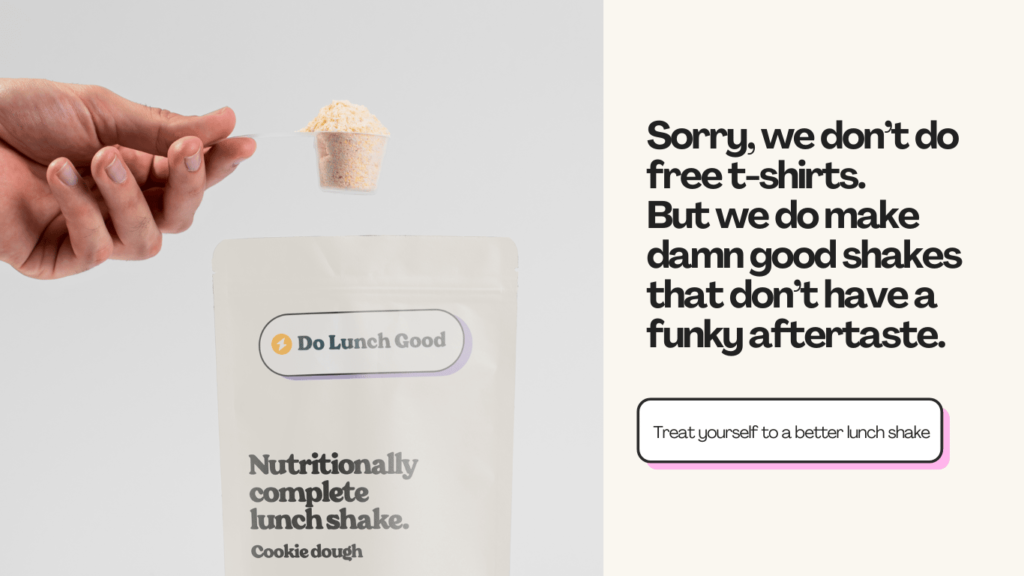
Is that going to win an award? Nope.
But what it does do is speak directly to customers’ pain points, reflect their language back at them and draw a line between you and your competition.
Customers are going to remember that when they see it. Huel customers are going to get the reference right away and think about switching. And you’ve planted your flag in the sand.
And that’s 90% of the battle.
🧠 You don’t have to use this to diss your competition
Using buyer lingo doesn’t have to mean having a pop at your competition. (We just did that because we got targeted with a Huel ad earlier and saw some of these comments.)
Brands like Wild Dose are killing it with copy that is very clearly rooted in mirroring their customers’ language.
By using phrases like “tummy issue hottie” and “No more uncomfortable meals, no more lying on the floor with your knees to your chest. Uncomfortable tums have met their match in the form of some tiny little pills.” you can just feel their team have done their research to really understand what their customers feel and mirror that back to them in their copy.
Put this to work: are there any customer reviews you can sprinkle into your copy? Any ways you can use competitor reviews to punch up your USPs? Any funny little phrases customers have said that you can use in your ads to make them more eyeball-grabbing and memorable?
And if you want a quick win, see if you can swap out the headline above your social proof section for one of your more memorable reviews. Not only will it be more effective, but people skimming will read an actual review and not a “Hear from our customers” headline.
That’s what we call a win win.
Dive into more free tips and tricks 👇
How Starface use orthography to build a killer brand voice their customers love
The words you write matter. But so do your full stops, emojis and lowercase letters. Learn how to turn punctuation into a powerful part of your brand voice.
Why Oatly’s brand voice is so damn good (and how yours can be, too)
We dig into the three layers of brand voice (10,000ft, 1,000ft, ground level), show how Oatly nails each one and how you can do it for your own brand.
The weekly newsletter that takes your brand’s copy from “meh” to “hell f*cking yeah!”
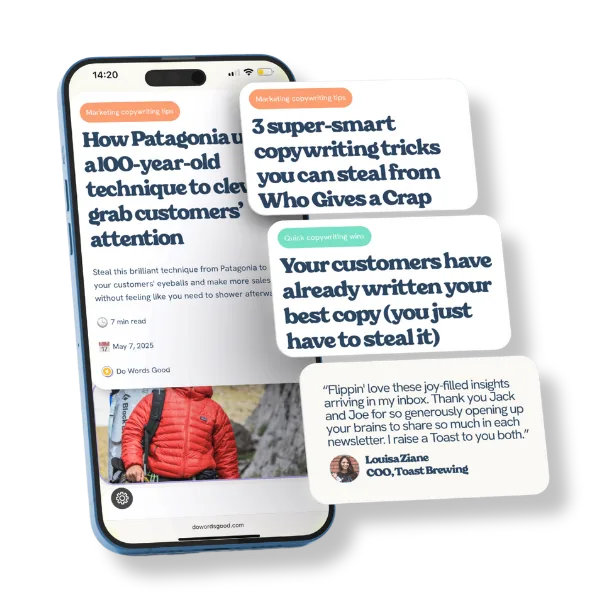
Read every week by legends at brands like these












